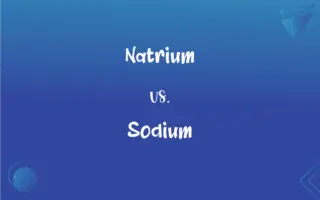Cloud Point vs. Pour Point: What's the Difference?
Edited by Aimie Carlson || By Janet White || Published on March 5, 2024
Cloud point is the temperature at which a liquid begins to form wax crystals, while pour point is the lowest temperature at which it can still flow.

Key Differences
Cloud point refers to the temperature at which certain components (usually waxes) in a liquid begin to solidify and form a cloudy appearance. This is a critical property for oils and fuels, as it indicates the onset of wax precipitation under cooling conditions. Pour point, on the other hand, is the temperature at which a liquid becomes semi-solid and loses its flow characteristics. It marks the limit of a liquid's ability to flow under the influence of gravity.
In the context of petroleum products and lubricants, the cloud point is an important measure to assess their performance in cold conditions, particularly for diesel fuels and biodiesel. It helps in understanding at what temperature the product may start to pose problems due to wax formation. The pour point is equally crucial, as it informs users about the lowest temperature at which these products can be stored and used without solidifying.
The cloud point is associated with the appearance of the first solid particles in a cooling liquid, the pour point is more about the practical usage limit of the liquid. Both points are essential for the formulation of products intended for use in varying temperatures, ensuring they remain functional in their intended applications.
The determination of the cloud point and pour point has significant implications in the transportation and storage of various fluids. For instance, knowing the cloud point of biodiesel can help in designing appropriate fuel blends for winter use, while the pour point is vital for ensuring that lubricating oils will not solidify in the engines during cold starts.
Understanding both the cloud point and the pour point of a substance is crucial for industries that operate in environments subject to a wide range of temperatures. These measures help in ensuring the reliability and efficiency of fuels, lubricants, and other industrial fluids under different thermal conditions.
ADVERTISEMENT
Comparison Chart
Definition
Temperature at which wax crystals first form in a cooling liquid.
Lowest temperature at which a liquid remains pourable.
Significance in Industry
Indicates onset of wax precipitation in oils/fuels.
Determines the lowest temperature for storage/use of liquids.
Impact on Fluids
Affects clarity and flow properties at higher temperatures than pour point.
Indicates the temperature at which flow practically ceases.
Measurement Relevance
Essential for understanding fuel performance in cold weather.
Critical for ensuring fluid usability in low-temperature environments.
Application Examples
Important for diesel and biodiesel in cold climates.
Vital for lubricants and hydraulic fluids in machinery.
ADVERTISEMENT
Cloud Point and Pour Point Definitions
Cloud Point
A key parameter in assessing the cold weather usability of biodiesel.
Biodiesel's higher cloud point can lead to fuel gelling in winter.
Pour Point
Determines the storage conditions for various oils and fuels.
To prevent solidification, the storage area's temperature must be above the pour point.
Cloud Point
The threshold at which lubricating oils begin to exhibit cloudiness due to wax.
Monitoring the cloud point helps maintain engine efficiency in cold temperatures.
Pour Point
Indicates the performance limit of cooling liquids.
The coolant's pour point guarantees protection against freezing in the system.
Cloud Point
The onset of solidification in cooling liquids, affecting transparency.
As the temperature dropped to the cloud point, the oil began to look cloudy.
Pour Point
A crucial factor in the formulation of hydraulic fluids.
Fluids with a low pour point are preferred for outdoor machinery in cold climates.
Cloud Point
A critical quality control measure for petroleum products.
The product failed the specification as its cloud point was above the acceptable range.
Pour Point
The lowest temperature at which a liquid can flow.
The pour point of this lubricant is -20°C, suitable for winter use.
Cloud Point
The temperature at which wax crystals start forming in a liquid.
The cloud point of this diesel is at 0°C, indicating potential cold weather issues.
Pour Point
Reflects the cold temperature usability of engine oils.
High-quality engine oils have a low pour point to ensure smooth cold starts.
FAQs
How is the cloud point relevant in the fuel industry?
It indicates potential cold weather issues with fuels like diesel and biodiesel.
Can the cloud point affect engine performance?
Yes, a high cloud point can lead to wax formation in fuels, affecting engine efficiency in cold climates.
What is the cloud point?
The temperature at which waxes in a liquid start to crystallize, forming a cloudy appearance.
What does the pour point signify?
The lowest temperature at which a liquid can still flow.
Why is the pour point important for lubricants?
It ensures that lubricants will remain fluid in cold temperatures for machinery operation.
Do all liquids have a pour point?
Most liquids that solidify have a pour point, but the specific temperature varies widely.
What implications does the pour point have for hydraulic systems?
Hydraulic fluids must have a pour point low enough to ensure system operation in the expected temperature range.
How does the pour point relate to storage conditions?
Liquids must be stored above their pour point to ensure they remain in a fluid state.
Is the cloud point only relevant for petroleum products?
While it's often associated with petroleum, the cloud point is also relevant for any liquid that can crystallize, like certain chemicals and fats.
What role does the pour point play in vehicle operation?
A low pour point is crucial for ensuring that vehicle fluids flow freely in cold weather, preventing startup and operational issues.
Can the cloud point be a concern in tropical climates?
While less critical in warm climates, the cloud point can still affect storage and handling in cooler periods.
How is the cloud point measured?
By cooling a sample and observing the temperature at which a cloudy appearance first occurs.
Can additives affect the cloud point of a fuel?
Yes, additives can lower the cloud point, improving fuel performance in cold weather.
How does the cloud point impact fuel blending?
The cloud point influences how different fuels are blended for optimal performance in varying temperatures.
How does weather affect the relevance of the pour point?
In colder climates, the pour point becomes a more critical factor for fluid selection and use.
What measures can be taken if a liquid's pour point is too high for its intended use?
Pour point depressants can be added, or the liquid can be mixed with another with a lower pour point to improve its cold temperature performance.
Is the cloud point a fixed property of a substance?
The cloud point can vary with the composition of the substance and can be altered with additives.
Why is the pour point critical for marine applications?
Marine engines and equipment require fluids that remain fluid at the low temperatures encountered at sea.
How does the cloud point relate to biodiesel?
Biodiesel typically has a higher cloud point than petroleum diesel, requiring attention in cold weather usage.
What method is used to determine the pour point?
The pour point is determined by cooling the liquid and noting the lowest temperature at which it still pours.
About Author
Written by
Janet WhiteJanet White has been an esteemed writer and blogger for Difference Wiki. Holding a Master's degree in Science and Medical Journalism from the prestigious Boston University, she has consistently demonstrated her expertise and passion for her field. When she's not immersed in her work, Janet relishes her time exercising, delving into a good book, and cherishing moments with friends and family.
Edited by
Aimie CarlsonAimie Carlson, holding a master's degree in English literature, is a fervent English language enthusiast. She lends her writing talents to Difference Wiki, a prominent website that specializes in comparisons, offering readers insightful analyses that both captivate and inform.






































































